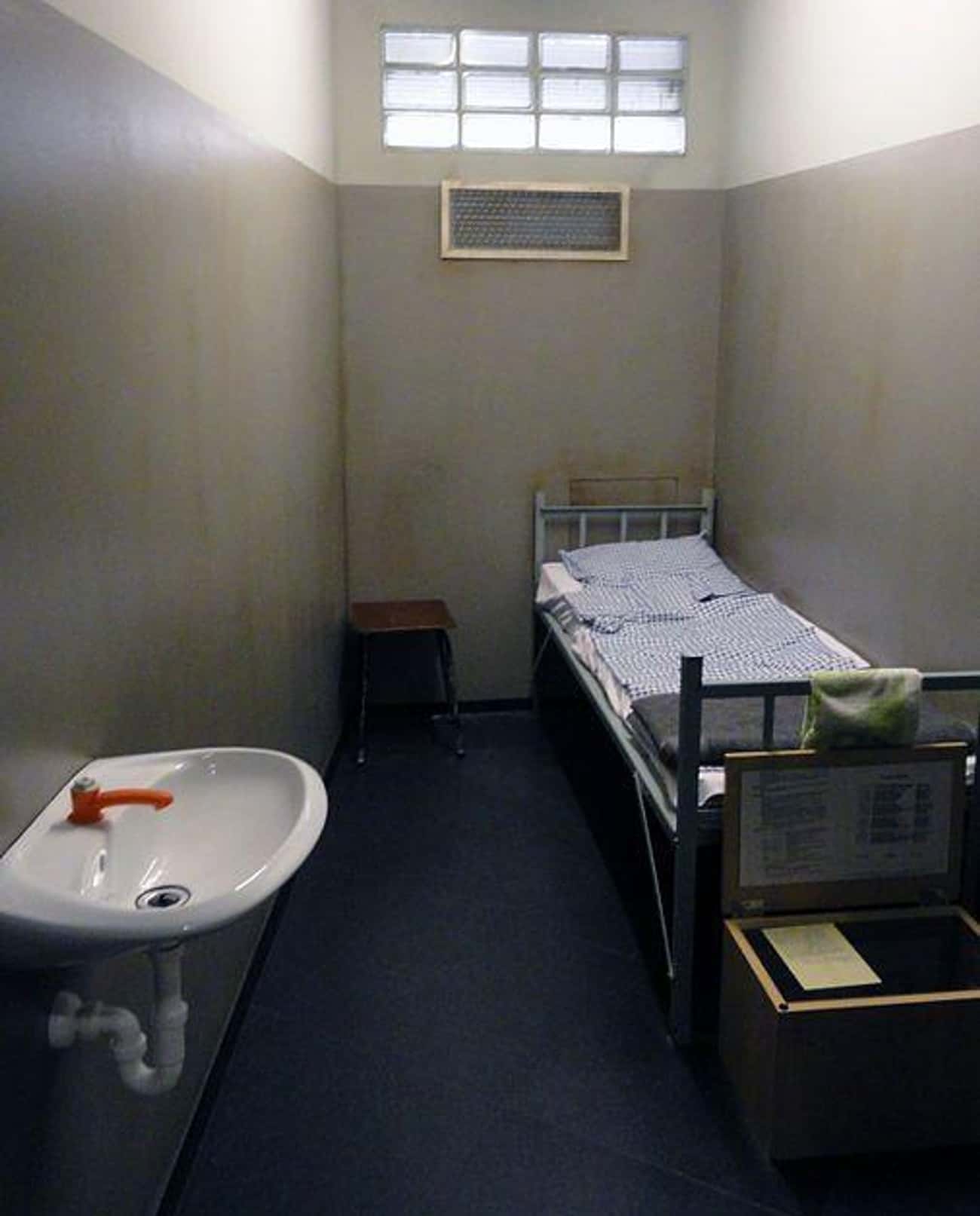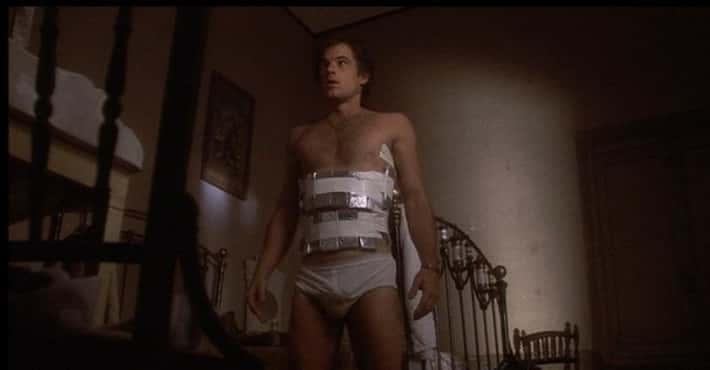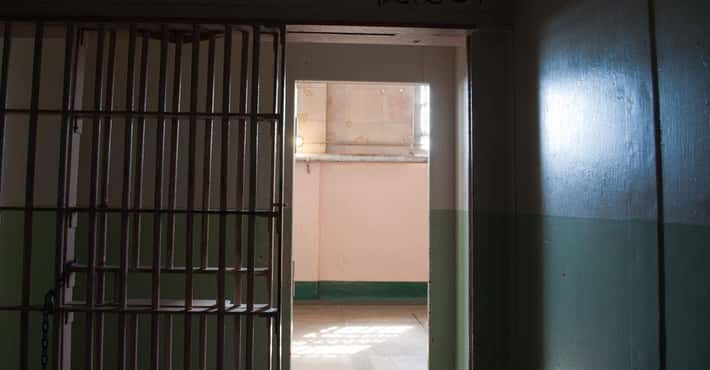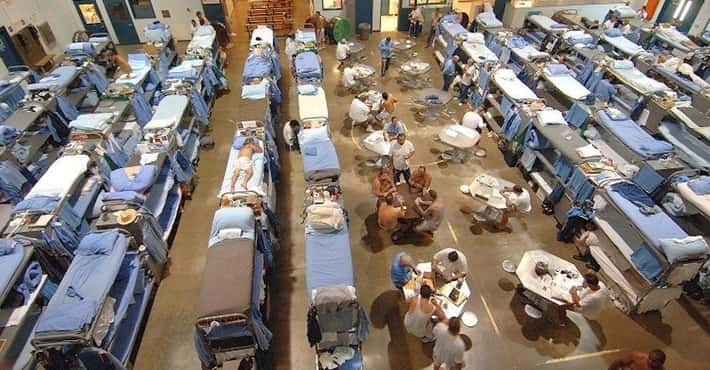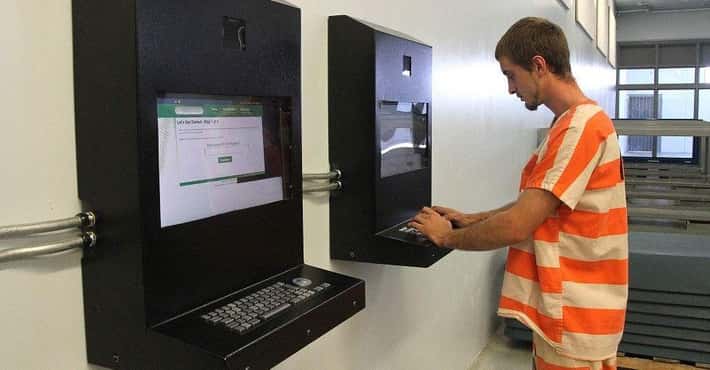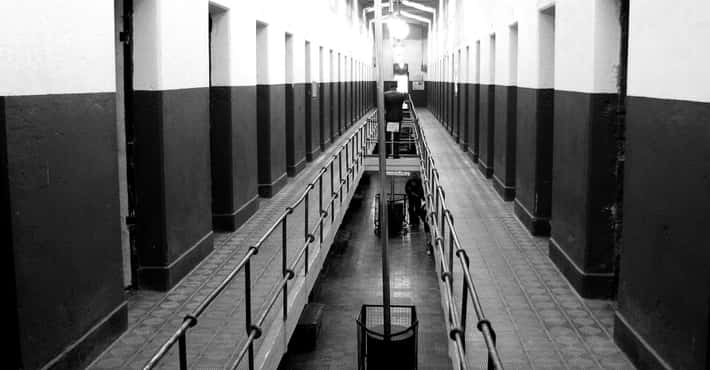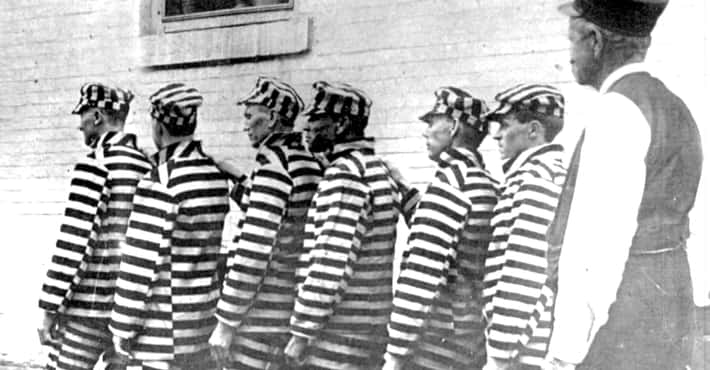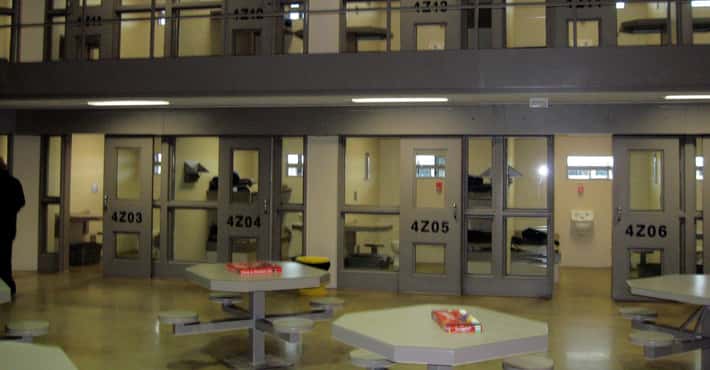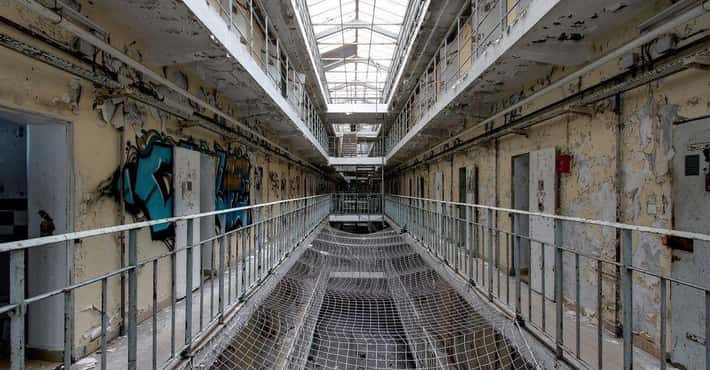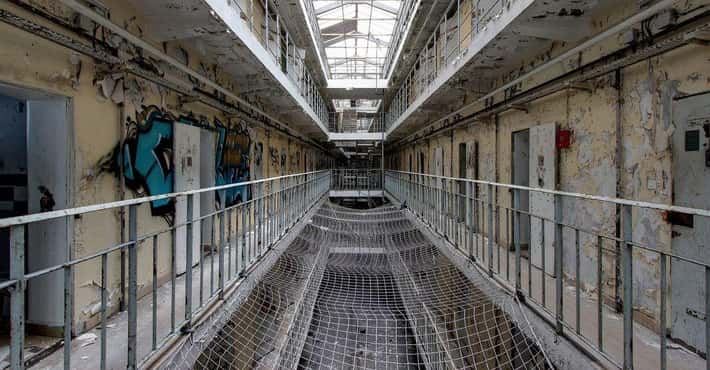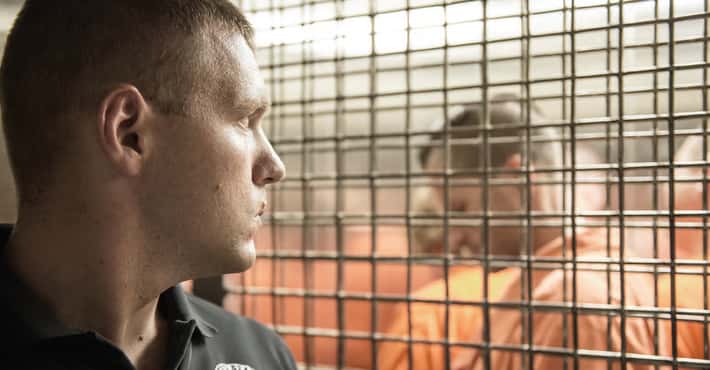Realities Of Daily Life In Florence ADX Supermax Prison
The Facility Was Deliberately Designed To Strip People Of Their Humanity
A facility built to house the most dangerous people in America is not going to be a nice place. Regardless of the inmates' offenses, they are still people, but the design of the facility works to remove all semblance of a normal life from those who are interred, and keep inmate movement as minimal as possible.
The parts of the building that the inmates can see are made of concrete and steel, and it's been compared to Guantanamo Bay, a detention camp notorious for its poor treatment of inmates. Laura Rovner, a law professor who provides representation for ADX inmates told CNN, "For many people, being confined at ADX in what will amount to a life sentence there really is kind of a form of living death. It just takes everything away from you. Your existence is limited to the four walls of this small cell and frankly not much else."
Inmates Are Held In Solitary Confinement For 23 Hours A Day
Solitary confinement units can be found in just about every correctional facility in the nation, from state units to supermax facilities. These areas are used to house inmates who represent a threat to the staff and others, or as a way to hold those who are apt to escape or cause problems within the institution.
ADX keeps all of its inmates in their own isolated space for 23 hours a day, allowing only one hour of time outside of their cell. The idea behind this holding technique is that those being confined in ADX would inevitably start trouble if they were allowed to mingle. Sometimes the one hour of free time is ended with little to no warning, meaning inmates are forced to stay in their cells for days at a time.
Supermax Is For The 'Worst Of The Worst'
ADX is most famous for holding the Unabomber, Ted Kaczynski, as well as national offenders like Terry Nichols and Umar Farouk Abdulmutallab. It also houses former FBI agent Robert Hanssen and Michael Swango, a doctor who is accused of poisoning 60 of his patients.
The lesser-known inmates in ADX are there for a variety of offenses: Many attacked fellow inmates at their previous holding facilities or attempted to escape medium-security institutions. Former ADX inmate David Shelby was incarcerated in the supermax after sending threatening letters to President Bill Clinton in order to convince him to release Charles Manson.
Essentially, if the justice system doesn't think they can reform an inmate, they're sent to supermax.
Inmates Can’t See Any Sky Or Grass
Photo: nonmisvegliate / Pixabay / Public DomainSupermax facilities like ADX are designed to keep inmate movement to a minimum, and to allow guards to have as much control as possible. Cells are built with a single 4-inch-wide window that's about 3 and a half feet off the ground. From an inmate's vantage point, there's nothing to see - not even the mountains surrounding the facility are visible.
Even when an inmate is out of their cell for an hour of free time, they're not allowed in areas where anything natural is around. ADX warden Robert Hood explained to CNN, "The architecture of the building is the control. You're designing it so the inmates can't see the sky. Intentionally. You're putting up wires so helicopters can't land."
The 7-By-12-Foot Cell Is Made Entirely Of Concrete
Photo: Allen Watkin / Wikimedia Commons / CC BY-SA 2.0There's nothing cushy about any correctional facility, regardless of whether it's a supermax or a county jail, but the cells at ADX are a different kind of uncomfortable. They're only 7 feet by 12 feet and are made completely out of concrete. There's nowhere anyone can relax or sit without feeling some sort of physical stress.
Former ADX inmate Travis Dusenbury explained, "My cell was all concrete. Every single thing, made out of concrete. The walls, floor, the desk, the sink, even the bed - a slab of concrete. Then you get a little fortified [recreation cage] that's outside that you get to go walk around in for an hour a day."
The Worst Inmates Are Kept In The Control Unit
It may not seem like there could be anything worse than being in a personal cell at ADX, but within ADX, there is a more secure facility known as the H-Unit, or the Special Security Unit, where those who are marked by the Department of Justice are held. The Special Security Unit is where inmates like Ramzi Yousef (the man behind the 1993 World Trade Center attack), and September 11, 2001, attack participant Zacarias Moussaoui are currently held.
The H-Unit doesn't just block these inmates off from the rest of the world - it blocks them off from everyone else at ADX. Warden Hood described the residents of the unit, saying, "They've been in jail. They've been in prison. They've [slain] staff. They've [slain] a visitor. They've earned, if you will, the right to go to Supermax."
Inmates Exchange Messages On Rolls Of Toilet Paper Through The Drain Pipes
Inmates inside ADX may be in cells next to one another, but they're not arranged in a way that makes conversation easy. In order to have anything that resembles a one-on-one chat, inmates have to be creative and use the very architecture of the building to their advantage.
Former ADX inmate Travis Dusenbury said that one way to communicate was to use a toilet paper roll as a combination bullhorn and ear horn that projects sound through the water pipes of the facility. In order to use this method, inmates have to make sure the water is cleared from the pipes and that they're next to someone who's comfortable chatting in such a way. It's not a perfect means of communication, but it allows them more intimate contact. Dusenberry explained:
You could take a whole toilet paper roll, put it over the drain in your sink or shower, and blow as hard as you could. That would blow the water down the pipes just far enough that the pipes were empty between you and your neighbor's cell. Then you keep holding the toilet paper roll over the drain, you talk into it, and your neighbor can hear what you're saying clearly. It depended on the cell you were in, if the pipes were lined up and all that, but you could usually contact your neighbor this way or even one more inmate down the line.
The Closest Human Contact Is 'Finger Handshakes' Through The Fence
There's no real personal contact inside ADX aside from whatever communication with a guard an inmate might have. Inmates rarely see one another, and when they are out of their cells, they have to wear leg irons, handcuffs, and chains.
If inmates do happen to see one another while they're getting in their one hour of recreation time, they can exchange a "finger handshake" through the fence that separates their recreation space. It's not a lot of contact, but in ADX, it's one of the few things that reminds inmates they aren't alone.
Inmates Don’t Have Much To Do All Day
While interred in a supermax like ADX, inmates have nothing but time and little to fill it with. They can get books from the library and spend the day reading, or they can do push-ups until they're exhausted. There are writing supplies, but former detainee Dusenbury says that they're not really applicable for long periods of use.
The pens used at ADX are not only expensive, but they’re floppy, short, and stubby in order to prevent possible harm. The amount of give that the pens have renders them essentially useless.
Medication Is Difficult To Get Ahold Of, And Is Normally The Wrong Kind
Inmates at ADX have basic medical needs like everyone else, but according to a former detainee, it's harder than it should be to get the proper medication. He said that not only were the guards skeptical of his issues with insomnia, but that they also tried to catch him sleeping at random intervals to prove he wasn’t suffering from the emotional and mental issues that were affecting him.
The former inmate told Vice that it took years for him to get approved for the medication he needed, and even then, he wasn't given the correct kind. He said it's not that the guards and doctors were being antagonistic, but that they just didn't care if he got the help he needed. There was no way for his body and mind to adjust to his medication because it was often incorrect - anyone who's suffering from a mental illness knows that this is the easiest way to make a condition worse than when it began.
There Is A Step-Down Program That Allows Inmates To Get Out Of Supermax
Photo: Jeffrey Beall / Wikimedia Commons / CC BY 4.0The good news about ADX is that there's a program that works to rehabilitate inmates in the supermax and get them into a standard maximum security facility before their release. Even though ADX houses national threat suspects, vicious slayers, and government spies, there are also detainees who are working toward returning to a normal life.
The step-down program takes at least a year to complete and it's made up of three phases where a person is slowly worked back into the general population. During the step-down program, individuals aren't just introduced to larger and larger groups -they're actually given group and one-on-one therapy sessions that allow them to develop coping mechanisms for mixing with the general population. This is a hard program to complete, but because of it, prison attacks fell 17% from 2008 to 2015.
Guards Are Reportedly Especially Hard On Inmates Who Disrupt Their Control
According to former detainees at ADX, if the guards find a reason to dislike an inmate, they make it their mission to challenge them. Inmate Jack Powers told The New York Times that an inmate on his cell block, Jose Vega, was a thorn in the side of the correction officers. He threw urine and feces while trying to disrupt the facility as much as possible. He was also mentally ill and believed that the guards were entering his cell at night to harm him.
Powers said that never happened, but they did bully him to an extreme degree. They dropped his food on the floor, they withheld his mail, and verbally attacked him. Powers said, "They started to break him. Almost like you see with pro wrestlers, like a tag-team-type thing, where one of them passes it off to the next and to the next and to the next."
Vega took his own life on May 1, 2010. Vega's family filed a lawsuit against ADX.
Many Inmates Become Delusional And Start Talking To Themselves
Because of ADX's attitude toward mental health, it's difficult to determine exactly how many of the inmates suffer from a form of mental illness. It's clear that a large swathe of the population struggles in one way or another, and that being confined to a cell 23 hours a day only exacerbates any potential mental health challenges. Some inmates claim to hear voices, and some have attempted to take their own lives.
Former ADX warden Hood told CNN, "I do know that when you put a person in a box for 23 hours a day and you tell them that's the rest of your life, that each person has their own coping skills... When you see a person disrobing, throwing feces at a staff member going by is that mental illness? Is that an issue where they're self-destructing?"
In some cases, detainees will work out until they're exhausted and unable to do anything but sleep. If an inmate is seen as being particularly unstable, it's possible that they'll end up fastened to a bed in a method called "four-pointing." Dr. Craig Haney, a psychology professor who was a main researcher with the Stanford Prison Experiment, said inmates kept in such a solitary state fall into "a profound level of what might be called 'ontological insecurity.' They are not sure that they exist and, if they do, exactly who they are."
There Have Been Several Lawsuits Over The Treatment Of Inmates And Their Mental Health
ADX and its fellow supermax facilities have been placed under a microscope for their draconian treatment of inmates that affects their mental health. In 2009, the Colorado Department of Corrections was sued by capital punishment inmate Nathan Dunlap for not being allowed to exercise or experience fresh air - two things that greatly effect a person's mental state.
In 2011, with the help of the law firm Arnold & Porter and the DC Prisoner's Project, ADX inmates filed suit against the institution for their treatment of persons with mental and physical health needs. The lawsuit claims that inmates are kept in conditions that make their suffering worse, and that many inmates suffering from mental and emotional issues are denied the medication they need. According to a former inmate, the staff psychiatrist told him he could not have his prescription for Seroquel (a medication that combats bipolar disorder) because they don't give "feel-good" medication there.
The lawsuit encouraged ADX to hire additional psychologists and allow for some inmates to be moved to facilities with minimal security and a focus on mental health. Former warden Hood believes that the supermax facility will be closed within a decade.




